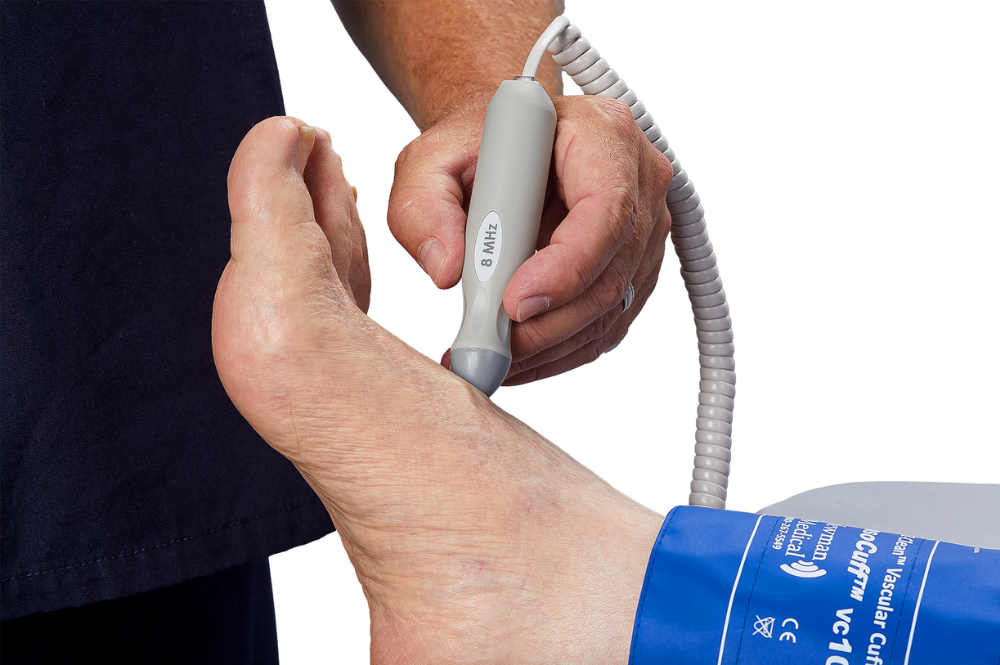Vascular Diagnostics: Their Importance in Managing PAD

Peripheral artery disease (PAD) is a common yet serious condition affecting millions of people worldwide. It occurs when arteries in the legs become narrowed or blocked due to plaque buildup, restricting blood flow and leading to symptoms like pain, numbness, and in severe cases, tissue damage. Vascular diagnostics may be required.
Early and accurate diagnosis of PAD is crucial for effective management and preventing complications such as heart attack, stroke, and limb loss. In this regard, advanced vascular diagnostics take an important part in identifying and managing PAD.
Understanding the Role of Vascular Diagnostics in PAD
Vascular diagnostics are essential tools in the detection and monitoring of peripheral artery disease. These diagnostics include a range of non-invasive tests that measure blood flow and evaluate the condition of the arteries in the lower extremities.
Two of the most common and effective diagnostic tools are Doppler ultrasound devices and Ankle-Brachial Index (ABI) systems.
Doppler Ultrasound: Precision in Blood Flow Measurement
Doppler ultrasound is a non-invasive test that uses high-frequency sound waves to measure the speed and direction of blood flow in the arteries. By analyzing the flow of blood through the vessels, Doppler ultrasound can detect areas of reduced blood flow indicative of narrowing or blockages. This test is invaluable in diagnosing PAD at an early stage when lifestyle changes and medical interventions can still have a significant impact.
Doppler devices are designed with healthcare providers in mind, offering high sensitivity and accuracy. These devices enable clinicians to detect even minor changes in blood flow, facilitating early diagnosis and improving patient outcomes.
Moreover, the portability and ease of use of these devices make them suitable for various clinical settings, from large hospitals to smaller clinics.
Ankle-Brachial Index (ABI): A Benchmark for PAD Diagnosis
The Ankle-Brachial Index (ABI) is another critical tool in the diagnosis of PAD. ABI compares the blood pressure in the ankle with that in the arm to determine the severity of blood flow reduction.
An ABI of less than 0.90 is generally indicative of PAD. The test is quick, simple, and highly reliable, making it a standard procedure in vascular diagnostics. ABI systems offer a precise and user-friendly solution for clinicians.
These systems provide automated, rapid measurements, reducing the possibility of user error and ensuring consistent, reproducible results.
The convenience of ABI testing also means it can be easily incorporated into routine check-ups, helping to identify PAD in asymptomatic patients who might otherwise go undiagnosed.
The Impact of Accurate PAD Diagnosis
Accurate diagnosis of PAD through vascular diagnostics is crucial for several reasons:
- It allows for early intervention, which can slow the progression of the disease and reduce the risk of serious complications.
- Patients diagnosed with PAD can benefit from lifestyle modifications, pharmacotherapy, and, in some cases, surgical interventions aimed at restoring proper blood flow.
- Early detection of PAD through tools like Doppler ultrasound and ABI testing can also uncover underlying cardiovascular issues, as PAD is often associated with a higher risk of coronary artery disease and cerebrovascular events.
- Regular monitoring of PAD using advanced vascular diagnostics can help manage the disease more effectively by tracking the progression of arterial blockages and the effectiveness of treatments, enabling healthcare providers to adjust treatment plans as necessary.
Integrating Vascular Diagnostics into Routine Practice
Effective PAD management relies on not only advanced diagnostics but also their smooth integration into daily clinical workflows. Here’s how healthcare providers can achieve this:
- PAD Screening Protocols: Establish clear protocols for identifying at-risk patients, especially those over 50 with risk factors. Routine ABI testing enables early PAD detection with minimal disruption to regular exams.
- Provider Training: Comprehensive training ensures accurate use and interpretation of Doppler and ABI diagnostics. Some medical devices manufacturers offer extensive resources to keep providers proficient and up-to-date.
- Patient Engagement: Educate patients on the importance of PAD screening and early detection. Informed patients are more likely to follow through with recommended tests and treatments.
- Workflow Efficiency: Optimize diagnostics workflow with portable, user-friendly devices. Integrate results into EHR systems for streamlined documentation and better care coordination.
Conclusion
Advanced vascular diagnostics are essential in detecting PAD early, guiding treatment decisions, and improving patient outcomes. By leveraging the precision and reliability of Doppler ultrasound and ABI systems, healthcare providers can enhance their ability to combat this challenging condition.
Elevate your vascular diagnostics with Newman Medical’s industry-leading solutions—check our ABI machines today.
Frequently Asked Questions (FAQ)
What is peripheral artery disease (PAD)?
Peripheral artery disease (PAD) is a condition where arteries in the legs become narrowed or blocked due to plaque buildup. This limits blood flow and can cause pain, numbness, and tissue damage in severe cases.
Why is early diagnosis of PAD important?
Early diagnosis of PAD helps manage the disease effectively and prevents serious complications like heart attack, stroke, and limb loss. It allows for timely lifestyle changes and medical interventions that can slow disease progression.
How does Doppler ultrasound help detect PAD?
Doppler ultrasound uses high-frequency sound waves to measure blood flow in the arteries. It can identify areas with reduced blood flow, indicating potential blockages or narrowing, aiding early diagnosis.
What is the Ankle-Brachial Index (ABI) test?
The ABI test compares blood pressure in the ankle and arm to assess the severity of blood flow reduction. An ABI under 0.90 usually indicates PAD and is a quick, reliable method for diagnosis.
How can healthcare providers integrate vascular diagnostics into routine practice?
Providers can establish screening protocols, ensure thorough training, engage patients in their care, and use portable, user-friendly devices. Integrating test results into EHR systems also improves workflow and patient care.
What are the benefits of using Doppler and ABI systems?
Both systems enable early and accurate detection of PAD, leading to better patient outcomes. Their precision and ease of use make them suitable for a range of clinical settings and help ensure consistent, reliable testing.
